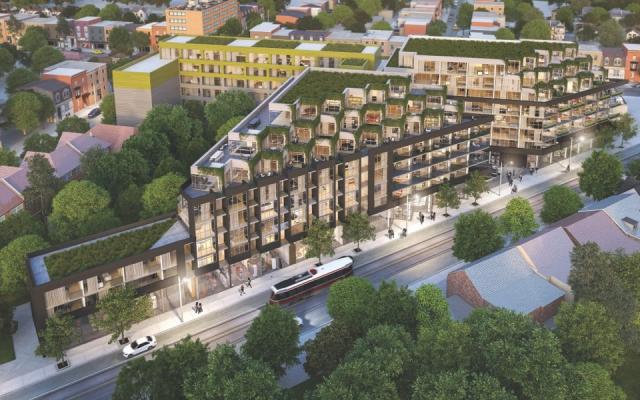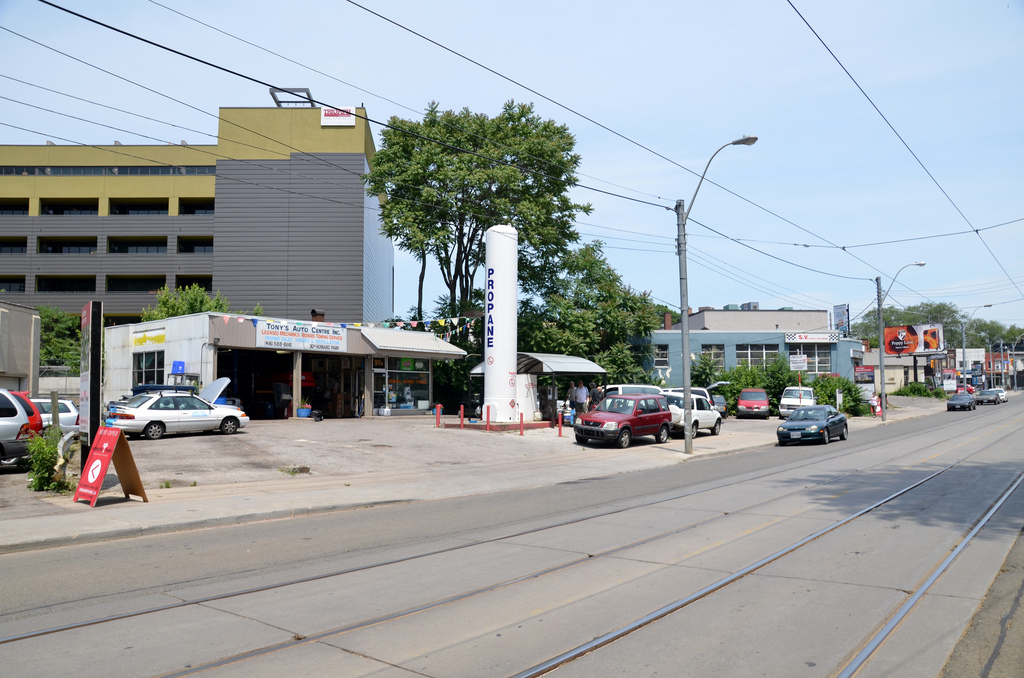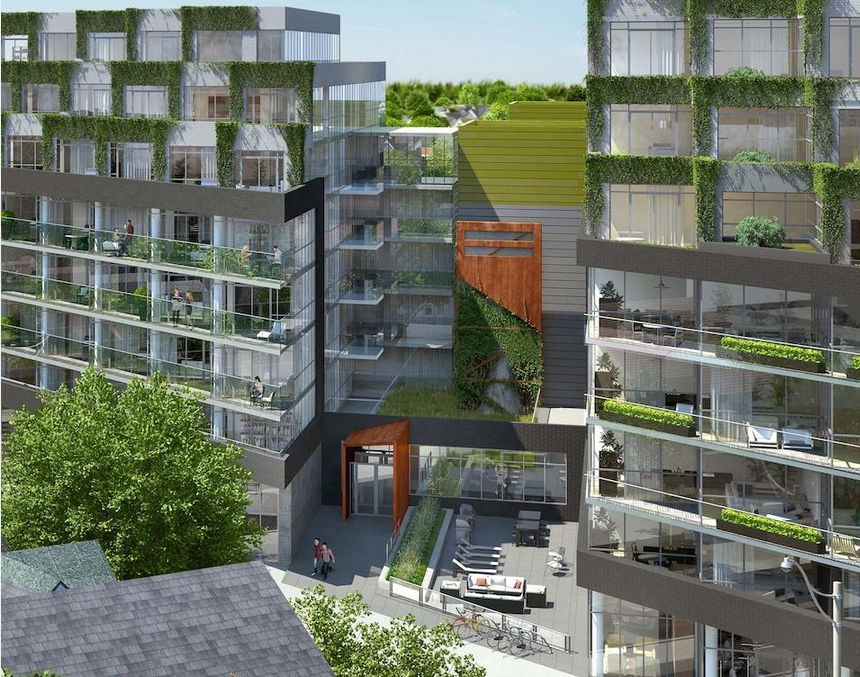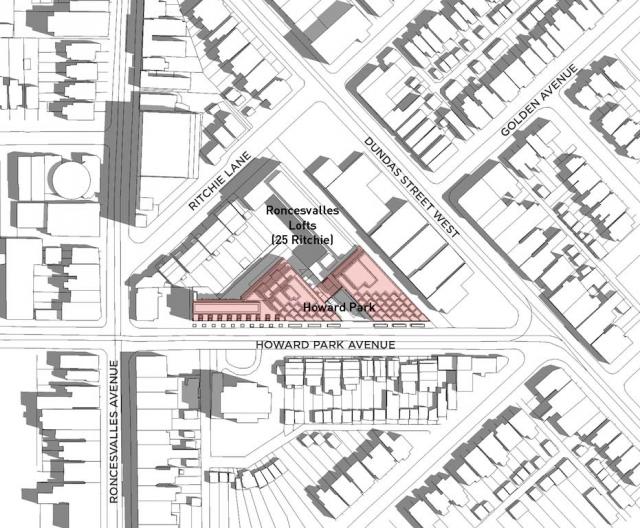(this is an interview I did and article I wrote for UrbanToronto) UrbanToronto’s Stephanie Calvet sat down with C.E.O. Mario Ribeiro of Triumph Developments to talk about Howard Park Residences, an urban infill project at the intersection of Dundas and Howard Park in Toronto's Roncesvalles neighbourhood. The first phase, an 8-storey building (far right) is under construction. Now the company is bringing its Phase Two western counterpart to the market. They will be joined by a multi-storey linking element, with the common entry and courtyard located between the two.
The site, with its odd triangular geometry, was previously home to a service station, aging garages and warehouses (see above). Removing these former industrial activities is an opportunity to tie eclectic Dundas and Roncesvalles Avenues, and to rethink the site as an active part of the public flow with a typology that combines high build density with a commercial program.
RAW Design, a local architecture firm with a portfolio of innovative mid-rise infill projects, crafted the buildings to the site and low-rise residential surroundings, breaking down the scale through massing and detailing. Vegetation that grows on each of its stepped metal terraces at the top floors imparts a softness to the elevation, inextricably part of the ‘look’ of the building that Triumph is committed to providing.
The project required an amendment to the existing zoning by-law to convert it from industrial to residential and mixed use. How has the project been received by the community?
It was well received. We've had no community pushback and lots of support from planners and the councillor. The community asked if commercial space was possible and we integrated that idea into the design.
What sorts of establishments would you like to see occupying the first floor retail/commercial spaces?
We are not looking for large franchises. This is a trendy neighbourhood. We are subdividing the space and hoping to get a variety of small shops, a daycare, maybe a bookstore…
There is more than the typical mix of unit types here. Who is your intended end-user? Is there anything larger than a 2-bedroom plus den?
We have a vast array of styles catered to a lot of different tastes: units tailored to the young professional, units with patios, units for families, including 3- and 4-bedrooms... Our biggest unit is 1400sf. We also have five 2-storey townhomes.
What building amenity program did your team develop that, from your standpoint, is in line with what residents want and need, practically speaking?
Because of the nature of the neighbourhood, there are lots of local amenities within walking distance. To keep construction costs and condo fees down, we provide typical meeting rooms, lounge, a media room, and gym but no pool.
The base building is charcoal-coloured brick and glass and then at the 6th floor, there is a shift both in plan and in exterior cladding. What material is used for the remaining storeys?
It is metal cladding and it goes with the window system. It is also perforated to allow plants to grab onto it.
Incorporating vegetation on the façade will give the building a very interesting presence on the street and from afar. This amount of 'building green' is unprecedented in Toronto...
The cascading vines, green roofs and planters will be maintained by the Condo Board as part of the 'common area’, and not up to each individual owner to maintain. That will keep it looking uniform. There is no stormwater tank but water will be dealt with on site through a combination of stormwater management solutions.
The site has access to transit (streetcar, subway, one of the stops of the new Union Pearson Express), lots of grade-level bike storage and a great Walk Score. What is the buildings’ parking ratio? Any provision for electrical vehicles?
The parking ratio is around 65-70% suites to parking stalls. At the moment, we’re seeing only 1 out of every 2 units asking for parking and the explanation is that the building is so well serviced by transit. On the other hand, bicycle spots are aplenty and they are in big demand. As for electrical vehicles, that is not final yet. In Phase 2, we provide storage lockers on the upper levels – so that residents have a locker almost across the hall. It became possible because we had to be creative in utilizing the oddly shaped resultant spaces in the core so we located storage lockers and services there.
It is great that parking and service access will be situated along the shared laneway off Howard Park Ave, making the lengthy (650') Howard streetfront more pedestrian-friendly and accessible for building, townhome and retail entries. Was it a challenge to locate it behind the building?
It might have been easier to situate it between the two buildings but it would have destroyed the look of the complex, and we didn’t want to interrupt the sidewalk. This way it’s off the laneway into Phase 1 and the parking garage under both buildings is all connected.
The building integrates many green initiatives: infill site, brownfield, green roofs, geothermal, stormwater, bike storage, etc. Are you going to take it through the LEED certification process?
Not LEED, although the plaque would look great on the wall! I’ve gone through the process as a trade on other projects and it is painstaking and very difficult administrating all the paperwork. We will comply with Toronto Green Standard Tier 2.
Incorporating geothermal systems (for heating and cooling) in condo building is not common practice in Toronto but the City gives government rebates and interest-free loans to help residential developers ‘go green’. Would you have incorporated it anyways because of the policy of your company or were government financial incentives necessary to make it reach the ROI you were expecting?
We didn’t get any government incentives. We started the process 3 years ago. Geothermal made economic sense in the long term because, if well implemented, it will save on the operation of the building.
Triumph has a keen focus on advancing and promoting sustainability, much like developers like TAS, Minto, and Tridel claim. Any market difference between them and yourselves?
Our scale of projects is smaller. The green initiatives on our buildings are maybe not as cost effective at this scale as Minto would do it. But we’re doing it because it’s the right thing to do – that’s the initial motivation – not for marketability reasons.
You have a European background. What aspects of European planning and design would you like to see inform building in Toronto?
Families living in mid-rise buildings is very common in Europe and we don’t see it as much here but I think there is a demand and a trend moving in that direction. I’d like to see buildings inserted into established neighbourhoods so families have access to amenities for their day-to-day, where they can can live and work close by, and people may even be able to go home for lunch. Large courtyard features, shared backyards, schools within walking distance, and several generations living in the same building – these are intimate living examples that I was familiar with. There is a sense of family and unity. We had these ideas in mind for our first project, Roncesvalles Lofts, and they continue to be valid for Howard Park. It is not a 25-storey structure; this is a place that makes sense to have an 8-storey building. It is a ‘community’ where you get to know your neighbours. The project will house 96 units – not a huge amount of people – and it is not intended to be transient with mainly short term rentals. Hopefully people move here and stay for a lifetime.
Stephanie Calvet is an architect and architectural writer based in Toronto. She can be found at www.stephaniecalvet.com





